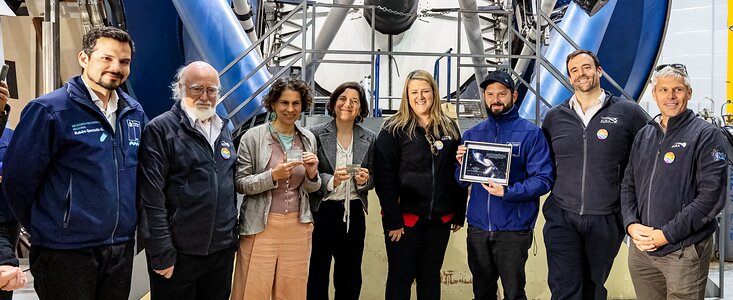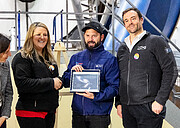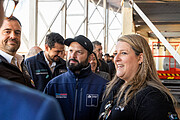President of Chile Gabriel Boric Visits Cerro Tololo
6 October 2023
Yesterday 5 October 2023 the President of Chile Gabriel Boric visited the Cerro Tololo Inter-American Observatory (CTIO) to meet with management and to reaffirm Chile's commitment to astronomy, and the protection of dark skies.
The President was accompanied by Minister for the Environment Maisa Rojas and Aisén Etcheverry, Minister of Science, Technology, Knowledge and Innovation. While touring the inside of the Víctor M. Blanco 4-meter Telescope enclosure they were briefed about the history of the AURA Observatory in Chile and the continued discoveries at CTIO done by the science community in Chile, US and beyond. The group saw Cerro Pachón in the distance, the location of the Vera C. Rubin Observatory, Gemini South of the International Gemini Observatory and the SOAR Telescope, and talked about the ongoing cutting-edge research at all of our flagship facilities and the new windows that will be open by Rubin.
The dignitaries were greeted by Alejandra Voigt (Head of Mission for AURA Observatory in Chile), Stuartt Corder (NOIRLab Deputy Director), Michiel van der Hoeven (Engineering Services Director) and Steve Heathcote (CTIO Associate Director).
The Minister of Science reiterated her desire to work with us on providing avenues for technical collaboration within Chile with the observatories.
The minister for the environment was briefed about the NOIRLab Sustainability project and the planned expansion of the solar panels and other initiatives on Cerro Pachón.
Later in the evening, the President attended a community event in Vicuña and reflected on the importance of protecting the night skies of Chile to safeguard humanity’s exploration of astronomy and the scientific advancement that Rubin's operation will represent. He also discussed Chile’s ideal geography for astronomy where the Andes mountains meet the Pacific, creating the perfect conditions for varied astronomical observations.
More information
NSF’s NOIRLab (National Optical-Infrared Astronomy Research Laboratory), the US center for ground-based optical-infrared astronomy, operates the International Gemini Observatory (a facility of NSF, NRC–Canada, ANID–Chile, MCTIC–Brazil, MINCyT–Argentina, and KASI–Republic of Korea), Kitt Peak National Observatory (KPNO), Cerro Tololo Inter-American Observatory (CTIO), the Community Science and Data Center (CSDC), and Vera C. Rubin Observatory (operated in cooperation with the Department of Energy’s SLAC National Accelerator Laboratory). It is managed by the Association of Universities for Research in Astronomy (AURA) under a cooperative agreement with NSF and is headquartered in Tucson, Arizona. The astronomical community is honored to have the opportunity to conduct astronomical research on Iolkam Du’ag (Kitt Peak) in Arizona, on Maunakea in Hawai‘i, and on Cerro Tololo and Cerro Pachón in Chile. We recognize and acknowledge the very significant cultural role and reverence that these sites have to the Tohono O’odham Nation, to the Native Hawaiian community, and to the local communities in Chile, respectively.
Links
- Photos of the Víctor M. Blanco 4-meter Telescope
- Videos of the Víctor M. Blanco 4-meter Telescope
- Photos of Gemini South
- Videos of Gemini South
- Photos of Vera C. Rubin Observatory
- Videos of Vera C. Rubin Observatory
- Photos of SOAR Telescope
- Videos of SOAR Telescope
Contacts
Luz María Aguirre
Communications and Institutional Relations Manager
AURA
Email: LAguirre@aura-astronomy.org
Amanda Kocz
Communications Manager
NSF’s NOIRLab
Tel: +1 520 318 8591
Email: amanda.kocz@noirlab.edu







